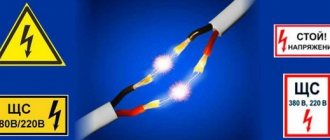The purpose of electrical safety training in the workplace
Before you start working at a company or other organization, you need to know how to carry out work safely. The danger of electric shock exists literally everywhere and it is unacceptable not to think about it when performing production tasks.
List of objectives:
- Familiarization of the newly arrived employee with the new workplace. The arriving worker cannot independently know about the dangers, so he must be instructed, including showing the equipment on which he will work.
- If an emergency occurs, you need to know what to do: how to provide first aid, where to evacuate, the procedure for reporting to management.
- What to do in the event of a fire, including where fire extinguishers and other fire extinguishing equipment are located.
After the briefing, it is necessary to interview the employee to find out whether he understood everything correctly and what his actions would be in the event of an electric shock or a high voltage hazard.
SAFETY REQUIREMENTS FOR OPERATING ELECTRICAL EQUIPMENT
5.1. Equipment with external power supply, depending on the method of protection against electric shock, is divided into class IV: - electrical equipment of safety class I, in addition to basic insulation, has a grounding contact of the power cord plug or a clamp on the housing with a permanent connection to the network, which serves to connect those accessible to touch metal parts to an external grounding device; — devices of safety class 0I, in addition to basic insulation, have a clamp for connecting accessible metal parts to an external grounding device; the power cord plug does not have a grounding contact; — electrical equipment of safety class II (with double or reinforced insulation, has, in addition to the main insulation, additional insulation, a sign at the entrance of the power cord into the housing) and does not require protective grounding or grounding; — class III devices are powered from an isolated current source with an alternating voltage of no more than 24 V or a direct voltage of no more than 50 V and do not have circuits with a higher voltage and do not require protective grounding or grounding. 5.2. If the degree of protection (class) is not indicated in the markings on the equipment or in the operating instructions (passport) or they are lost, then such devices must be checked by engineering and technical personnel to determine their suitability for further safe operation. It is prohibited to allow the use of such devices by customers (for example, refrigerators) if the degree of their protection is unknown. 5.3. To protect against electric shock, all accessible metal parts of Class I and Class 0I equipment must be grounded or neutralized. 5.4. The continuity of the circuit between the protective grounding terminal on the electrical installation and the grounding terminal on the panel or protective grounding bus must be checked by personnel inspection at the beginning of each work shift. It is prohibited to supply mains power to the electrical installation if the continuity of the protective grounding circuit is broken. 5.5. In the room where electrical equipment is operated, radiators and metal pipes for heating, water supply, sewer and gas systems must be covered with wooden gratings or other dielectric barrier devices, and the floors must be non-conductive. 5.6. Personnel are prohibited from connecting electrical equipment to the network if the insulation of the power cord and plug body is damaged, as well as other defects that may cause personnel to touch live parts. 5.7. If a malfunction is detected during the operation of electrical equipment, personnel must immediately disconnect the faulty device from the network and report this to their immediate supervisor. 5.8. It is prohibited to work with faulty equipment; work can be resumed only after the fault has been eliminated and there is a corresponding entry in the maintenance log by the person responsible for the serviceability of the electrical equipment. 5.9. It is prohibited to disconnect electrical equipment by pulling the plug from the socket by the cord; force must be applied to the body of the plug. 5.10. It is prohibited to transport carts over wires and cables, to step on electrical cables or cords of electrical equipment, to carry running electrical devices or leave them plugged in without supervision, or to throw plugs on the floor. 5.11. When connecting stationary equipment, the use of adapters and extension cords (except for special stabilizing devices) is prohibited, for which a sufficient number of plug sockets must be provided in the premises. 5.12. Workers are prohibited from using electrical equipment without first familiarizing themselves with the principle of its operation and the rules of safe operation (passport or instructions). 5.13. It is prohibited to check the functionality of electrical equipment in rooms that are not suitable for use with conductive floors, damp, and do not allow accessible metal parts to be grounded (for classes 0I and I). 5.14. Personnel are prohibited from independently repairing faults in electrical equipment; repairs are carried out by a worker with the required qualifications and only after disconnecting the device from the network. 5.15. It is prohibited to use electric stoves with open spirals, electric heaters without protective enclosures, and other electrical receivers with live parts that can be touched indoors. 5.16. It is prohibited to place the wires of portable lamps and electrified tools on wet surfaces, hot objects, or in places where they may be subject to friction, twisting, or tension. Wipe electrical installations connected to the network with wet rags. Wash the walls where electrical appliances are installed, cables and wires are laid. Clean the premises using a watering hose near the switchgear and electric motors installed on the floor.
Which employees should be interviewed?
Everyone, without exception, should have knowledge in the field of electrical safety, but at the same time it is necessary to carry out instructions:
- With employees who do not directly work with electrical receivers, that is, non-electrical personnel. This includes industrial cleaners, PC users, machine operators and others. That is, all persons who in their activities come into contact with devices operating on electric current.
- Electricians involved in the installation and repair of power equipment are required to know the structure of all devices and wiring diagrams. They undergo training according to a special program.
- Heads of departments, heads of sections and foremen must also undergo instructions given by their immediate supervisors.
Failure to provide instructions may result in negative consequences and penalties from supervisory authorities.
Who is assigned 1st EB group
Personnel who do not service electrical installations, but in their work have a risk of receiving any degree of electric shock, are classified as non-electrical workers. These include:
- administrative workers not involved in maintenance, repair and installation of electrical equipment;
- office employees who use electrical appliances (lamps, kettles, microwave ovens) and equipment (computers, printers, scanners, faxes) in their work process.
Non-electrical personnel
These categories are assigned 1 electrical safety group based on the instructions provided and subsequent knowledge testing, which is a survey on the topics covered.
Procedure for conducting induction training on electrical safety
Enterprises establish a procedure for instructing:
- The department of the chief power engineer or the person responsible for the electrical facilities of the facility is developing a program according to which the event will be carried out. The document is agreed upon and approved by order.
- A responsible person or several persons (electrical safety commission) is appointed for the instructions. As a rule, this is a certified specialist in the field of electrical safety.
- The time of the event is set.
- A classroom is pre-equipped, equipped with a projector, posters and other aids for conducting classes.
- After the briefing, a note is made in a special journal, the form of which is approved by the administrative document.
Possible consequences of non-compliance
Electrical safety is an integral part of occupational safety. Failure to comply with its requirements can be of 2 types: violation of established rules for handling equipment and lack of personnel training. This can also include improperly executed TB documents.
If accidents occur at work, the following are responsible for the consequences:
- the head of the institution - as the person responsible for everything that happens in this organization;
- employee responsible for TB (and ES);
- an employee who committed violations that led to an accident.
Incidents that resulted in human death, moral and material damage, environmental pollution, etc. are subject to investigation. Depending on the situation, it is carried out by labor safety inspectors, representatives of departments and supervisory authorities. If the investigation reveals an offense (crime), the materials are sent to court.
Persons responsible for an accident may be punished:
- disciplinary;
- administrative;
- material;
- criminal.
If an accident occurs to a person who handled electrical equipment without at least 1 group, then all managers who supervise the activities of this employee will be held accountable. Punishment will also follow for the employee responsible for instruction in electronic safety.
However, personnel are subject to administrative or disciplinary liability even in the absence of emergency incidents. This may occur as a result of violations identified during scheduled and unscheduled inspections conducted by departmental or supervisory authorities. Violations may include:
- failure to comply with briefing deadlines;
- incorrect design of the journal or its absence;
- carrying out work with electrical appliances by a person who does not have a clearance group.
Depending on the characteristics of the institution, punishment may apply to the head of the enterprise, heads of departments and the person responsible for TB.
How to register for training
As noted earlier, a note indicating that the employee has been instructed to be entered in a special journal.
Contents of the column in the journal:
- the first column indicates the serial number;
- in the second column the full name and initials of the employee are written;
- in the third - position;
- in the next column there is space for the signature of the person being instructed;
- in the fifth column, the responsible person who conducted the instruction signs.
The journal requirements are as follows:
- The pages must be numbered and bound.
- On the last page the total number of sheets is indicated and the organization's stamp is placed.
- The start and end dates of the journal are written on the cover.
- Storage of the log is necessary for 5 years, unless a different period is provided for by local regulatory acts of the enterprise.
- When designing and filling out the journal, you must not make mistakes, blots, typos, and much more. This is a document that must be written in legible handwriting.
What measures are taken to maintain electrical safety?
The enterprise administration ensures the level of labor safety of workers interacting with electrical installations through the following periodic measures:
Senior employees control the access of junior employees to work
- control of access to work;
- obtaining a permit to organize a workspace and perform work in accordance with the conditions of clause 5.14 of the POTEE;
- monitoring the execution of the work process;
- issuing an order, decree or list of tasks for current work;
- coordinating the schedule of work breaks, changes of workplace and duration of work.
Frequency
Introductory training in electrical safety should be carried out after hiring employees, without exception. This is the first knowledge gained during employment.
Electrical safety poster for enterprise
After obtaining theoretical skills, the employee must undergo other types of instruction (see Table 1).
Table 1. Types of electrical safety training
| Type of instruction | Description |
| Primary | After employment, the employee must perform duties at the workplace. Before performing work, the employee must be familiarized with the workplace, including the electrical equipment located in the work area. In this regard, initial training is carried out. |
| Current | In terms of information content, this briefing is the same as the initial one. It must be carried out so that the employee does not forget about safe work practices. During a work shift, an employee is engaged in performing production tasks, but in the process of work he forgets about safety, and to avoid this, it is necessary to periodically remind about the correct operation of electrical equipment. As a rule, it is carried out once every six months, unless other dates are determined by local regulations. |
| Unscheduled | It is carried out when upgrading equipment, when purchasing modern equipment, as well as if changes are made to the technological process, safety instructions or new operating requirements are established. |
| Target | If an employee is sent to perform tasks under a work permit, then he must first be instructed. Instruction is provided in the direction in which the work is being carried out. |
CAUSES OF ELECTRIC SHOCK
3.1. Human contact with non-insulated live parts of an electrical installation. 3.2. Touching metal parts of electrical installations that are energized as a result of insulation failure due to a faulty grounding device. 3.3. Malfunction of electrical devices (equipment, instruments, starting devices, wires, grounding). 3.4. The use of portable lamps and power tools of higher voltage than those established by the rules in rooms with increased and special danger. 3.5. Violation of rules and instructions for the operation of electrical equipment.
What is the briefing for?
Introductory training in the field of electrical safety is necessary for:
- In order to explain to employees what technically complex equipment they will have to work on.
- Knowledge of specific production features.
- For preventive purposes, to avoid injury when handling power equipment.
- To ensure that there is no damage to the equipment.
- Knowledge in the field of working with electrical equipment.
- Gaining skills in working with technical devices in production.
All newly arrived employees, as well as experienced employees, must receive instructions from their immediate supervisors. If work is carried out with complex mechanisms, then this always poses a danger from burns to death, therefore, at the legislative level, all measures are provided to prevent these circumstances.
Preventive measures to prevent injury to employees are necessary.
ELECTRICAL SAFETY REQUIREMENTS DURING OPERATION
Make sure that electrical plugs, electrical sockets and switch covers are intact.
Check the presence of primary fire extinguishing equipment and personal respiratory protection equipment in the room in case of smoke.
Do not connect electrical appliances to the electrical network with wet (damp) hands.
Follow the rules for operating electrical appliances, do not expose electrical appliances and equipment to mechanical shocks, and do not allow them to fall.
Do not touch exposed (damaged) wires and other live parts that are energized.
It is not allowed to use electrical appliances if they are malfunctioning, sparking, insulation failure, etc.
Cables and wires of electrical appliances must be protected from accidental mechanical damage and contact with hot, damp, oily surfaces.
Do not carry out repairs or adjustments to faulty electrical appliances yourself.
Yes need. Electrical safety training must be carried out for all workers who in any way come into contact with electrical devices or electrical networks during work. Considering that virtually any work today involves appropriate contact, almost all employees are subject to electrical safety training. In other words, if employees of an organization work on a computer or with other electrical devices, they are subject to appropriate instruction.Non-electrical personnel (which includes most employees of educational organizations) must undergo training and an oral knowledge test once a year. This category of employees is assigned Group I for electrical safety (at least once a year). The list of positions and professions of such employees is determined by the head of the organization.
Thus, group I on electrical safety applies to non-electrical personnel (not related to electrical and electrical engineering personnel). The list of positions and jobs requiring classification of production personnel into group I is determined by the head of the organization (separate division). Personnel who have mastered the electrical safety requirements related to their production activities are assigned group I with registration in a log, which must contain the last name, first name, patronymic of the employee, his position, the date of assignment of group I for electrical safety, and the signature of the person being inspected and the inspector. Assignment to group I is made through instruction, which, as a rule, should be completed with a knowledge test in the form of an oral survey and (if necessary) a test of acquired skills in safe working methods or providing first aid in case of electric shock. Assignment of group I is carried out by an employee from among the electrical personnel who has group III in electrical safety, appointed by order of the head of the organization.
This is provided for by Order of the Ministry of Labor of Russia dated July 24, 2013 N 328n “On approval of the Rules for labor protection during the operation of electrical installations.” A similar approach is enshrined in the Rules approved by Order of the Ministry of Energy of the Russian Federation dated January 13, 2003 N 6 “On approval of the Rules for the technical operation of consumer electrical installations.”
Application
SAMPLE INSTRUCTIONS FOR CONDUCTING ELECTRICAL SAFETY INSTRUCTIONS FOR NON-ELECTRICAL PERSONNEL
1. General electrical safety requirements
Electrical safety is understood as a system of organizational and technical measures to protect people from the effects of electric current, electric arc, static electricity, and electromagnetic fields.
When using any electrical appliances or devices, you must always remember that incorrect handling, faulty condition of the electrical wiring or the electrical appliance itself, or failure to comply with certain precautions can lead to electric shock. Faulty electrical wiring can cause wires to ignite and cause fires.
Non-electrical personnel - workers who, during their working hours, use lighting, heating electrical appliances, personal computers and other office and household appliances (hereinafter referred to as electrical appliances), the operation of which may result in electric shock. In accordance with the requirements of Order of the Ministry of Energy of Russia dated January 13, 2003 N 6 “On approval of the rules for the technical operation of consumer electrical installations,” non-electrical personnel performing work that may pose a risk of electric shock are assigned Group I for electrical safety.
Non-electrical personnel must be familiar with the rules for providing first aid to victims of electric current.
Assignment to group I is made through instruction, which, as a rule, should end with a knowledge test in the form of an oral survey and (if necessary) a test of acquired skills in safe working methods or providing first aid in case of electric shock. The assignment of electrical safety group I is carried out by an employee from among the electrical personnel with an electrical safety group of at least III. Assignment of electrical safety group I is carried out at least once a year.
The assignment of group I for electrical safety is documented in a journal of the established form (Table 1).
Table 1
Logbook form for assignment of group I for electrical safety to non-electrical personnel
N p/p
| Full Name | Division name | Position (profession) | Date of previous assignment | Date of assignment | Signature | |
| being checked | inspector | |||||
Electrical safety group I is assigned to non-electrical personnel after undergoing electrical safety training. If necessary, training and testing of knowledge on electrical safety is carried out.
Electrical safety training is carried out at least once a year by familiarizing non-electrical personnel with the following text.
2. Electrical safety rules
When operating electrical appliances, workers may be exposed to the following hazardous production factors:
— electric shock when touching live parts;
— faulty insulation or grounding;
- sparking;
- fire.
During work, as well as during rest breaks, the following electrical safety rules should be strictly followed:
— before using electrical appliances for the first time, carefully read the operating instructions for this electrical appliance;
— turn on electrical appliances by inserting a working plug into a working socket;
— if an electrical appliance malfunctions, stop working, disconnect the electrical appliance from the network and inform your immediate supervisor;
— strictly comply with the requirements of posters and safety signs in buildings, premises and on the territory;
— do not step on electrical wires and temporary wiring cables laid on the floor (ground) surface;
— persons operating electrical appliances are required to strictly comply with fire safety rules, know the location of primary fire extinguishing equipment, as well as the location of their emergency shutdown;
— the victim or eyewitness of the accident must immediately report to his immediate supervisor about each accident;
— during the operation of electrical appliances, personnel must keep the workplace clean.
Persons who fail to comply with or violate these Instructions are held accountable in accordance with the legislation of the Russian Federation.
3. Electrical safety requirements before starting work
Check for external damage to electrical appliances, wires and cables.
Make sure that electrical plugs, electrical sockets and switch covers are intact.
Check the presence of primary fire extinguishing equipment and personal respiratory protection equipment in the room in case of smoke.
4. Electrical safety requirements after completion of work
Do not connect electrical appliances to the electrical network with wet (damp) hands.
Follow the rules for operating electrical appliances, do not expose electrical appliances and equipment to mechanical shocks, and do not allow them to fall.
Do not touch exposed (damaged) wires and other live parts that are energized.
It is not allowed to use electrical appliances if they are malfunctioning, sparking, insulation failure, etc.
Cables and wires of electrical appliances must be protected from accidental mechanical damage and contact with hot, damp, oily surfaces.
Do not carry out repairs or adjustments to faulty electrical appliances yourself.
5. The effect of electric current on a person
The peculiarity of the effect of electric current on a person is its invisibility. This feature determines the fact that almost all working and non-working places where there is live electrical equipment are considered dangerous. In each such place, the danger of electric shock to a person cannot be considered excluded. Electric current, as well as electric arc (lightning), static electricity, and electromagnetic field can affect a person.
If an electric current flows through the human body, it can cause a variety of effects on various organs, including the central nervous system.
The human body is a conductor of electric current. However, the conductivity of living tissue, unlike the conductivity of conventional conductors, is determined not only by physical properties, but also by complex biochemical and biophysical processes inherent in living matter. As a result, the resistance of the human body is a variable value that has a nonlinear dependence on many factors, including the condition of the skin, physiological processes occurring in the body, parameters of the electrical circuit, and the state of the environment.
Passing through the human body, electric current can produce thermal, electrolytic, mechanical, and biological effects:
the thermal effect of the current manifests itself in burns of certain parts of the body, heating to high temperatures of blood vessels, blood, nervous tissue, heart, brain and other organs located in the path of the current, which causes serious functional disorders in them;
the electrolytic effect of the current is expressed in the decomposition of organic liquids, including blood, which is accompanied by significant disturbances in their physicochemical composition;
the mechanical (dynamic) effect of current is manifested in the appearance of pressure in the blood vessels and tissues of the body when blood and other fluids are heated, as well as displacement and mechanical tension of tissues as a result of involuntary muscle contraction and the influence of electrodynamic forces;
the biological effect of current is manifested in irritation and excitation of living tissues of the body, as well as in disruption of internal bioelectric processes occurring in a normally functioning organism.
If the current passes directly through muscle tissue, then excitation manifests itself in the form of involuntary muscle contraction. This effect is called direct. However, the effect of current can be not only direct, but also reflexive, i.e. through the central nervous system, which leads to serious disruption of vital organs, including the heart and lungs.
6. Classification of electrical injuries
Conventionally, all electrical injuries can be divided into local and general.
Local electrical injuries include local damage to the body or pronounced local damage to the integrity of body tissue, including bone tissue, caused by exposure to electric current or an electric arc. Local electrical injuries include electrical burns, electrical marks, skin metallization, mechanical injuries, and electroophthalmia.
Visual signs of current exposure are sharply defined spots of gray or pale yellow color on the surface of the human body. The top layer of skin becomes necrotic.
General electrical injuries (electrical shocks) occur when living tissues of the body are excited by electric current flowing through it and are manifested in involuntary convulsive contractions of the muscles of the body. In this case, the entire body is at risk of damage.
An electric shock may not lead to the death of a person, but may cause disorders in the body that may appear after a few hours or days (the appearance of cardiac arrhythmia, angina pectoris, absent-mindedness, weakening of memory and attention).
Causes of death from electric current can be: cessation of cardiac function, respiratory arrest and electric shock.
Electric shock is a kind of severe neuro-reflex reaction of the body in response to excessive irritation by electric current.
In case of shock, immediately after exposure to electric current, the victim enters a short-term phase of excitation, when he reacts sharply to the pain that has arisen, his blood pressure rises. This is followed by a phase of inhibition and exhaustion of the nervous system, when blood pressure drops sharply, the pulse drops and quickens, breathing weakens, and depression occurs. The state of shock lasts from several tens of minutes to a day. After this, either the death of the person or recovery may occur. The outcome of the effect of current on the human body depends on the value and duration of the passage of the current through his body, the type and frequency of the current, the individual properties of the person, his psychophysiological state, the resistance of the human body, voltage and other factors.
7. Step voltage
The step voltage is caused by the spreading of electric current over the surface of the earth in the event of a single-phase ground fault of the electric wire.
If a person stands on the surface of the earth in the zone of spreading electric current, then voltage will arise at the length of his step and electric current will pass through his body. The magnitude of this voltage, called step voltage, depends on the width of the step and the location of the person. The closer a person stands to the fault point, the greater the step voltage.
To avoid electric shock, a person should leave the step voltage zone in short steps, without lifting one leg from the other.
If a person falls (on his hands), the magnitude of the step voltage increases significantly, and therefore the magnitude of the current that will pass through his body and vital organs - the heart, lungs, brain.
8. First aid for electrical injuries
First aid is a set of measures aimed at restoring or preserving the life and health of the victim, carried out by non-medical workers.
One of the most important provisions of first aid is its urgency. Therefore, such assistance can and should be provided in a timely manner by those who are close to the victim.
In case of electric shock to a person:
eliminate the impact of damaging factors on the body (free from electric current, assess the condition of the victim);
determine the nature and severity of the injury, the greatest threat to the life of the victim and the sequence of measures to save him;
restore airway patency; if there is no pulse in the carotid artery, a precordial blow should be applied and resuscitation should begin;
call an ambulance or a doctor or take measures to transport the victim to the nearest medical facility;
Maintain the casualty's basic vital functions until a medical professional arrives.
The release of the victim from the action of electric current is carried out in electrical installations up to 1000 volts by turning off that part of the installation that the victim touches. If it is impossible to turn off the installation in this case, other measures must be taken to free the victim. To free the victim from live parts or wires, you should use protective equipment, a rope, a stick, a board or any other dry object that does not conduct electric current. You can pull the victim by the clothes (dry), while avoiding touching surrounding metal objects and parts of the body not covered by clothes. To insulate their hands, the person providing assistance should wear insulating gloves or wrap their hands in dry clothing. You can also isolate yourself by standing on a rubber mat, dry board or any non-electrically conductive bedding, clothing, etc. When freeing the victim from live parts, it is recommended to use one hand.
If an electric current passes through the victim into the ground and he convulsively squeezes the current-carrying element in his hand, you can interrupt the current by separating the victim from the ground (pulling him by the clothes, placing a dry object under the victim). If there is no daylight in the room or at night, it is necessary to provide lighting for the affected area with a separate light source.
After releasing the victim from the action of electric current, it is necessary to assess his condition:
— consciousness (clear, impaired, absent);
- skin color (pink, pale, bluish);
- breathing (normal, impaired, absent);
- pulse (good, bad, absent);
- pupils (narrow, wide).
If the victim has no consciousness, breathing, pulse, bluish skin, dilated pupils, then we can assume that he is in a state of clinical (sudden) death. In this case, it is necessary to immediately begin resuscitation measures and ensure that a doctor (ambulance) is called.
If the victim is conscious, but was previously unconscious, he should be laid on dry objects, unbuttoned clothes, create a flow of fresh air, warm the body in cold weather or provide coolness on a hot day, create complete rest, continuously monitoring the pulse and breathing , call a doctor.
If the victim is unconscious, it is necessary to monitor his breathing and, in case of breathing problems, ensure that resuscitation measures are performed. Only a doctor can finally decide the state of health of the victim.
In case of lightning, the same assistance is provided as in case of electric shock.
If it is impossible to call a doctor to the scene of the incident, it is necessary to ensure that the victim is transported to the nearest medical facility. The victim can be transported only if breathing is satisfactory and the pulse is stable. If the condition of the victim does not allow him to be transported, it is necessary to continue to provide assistance.
If the victim's clothing catches fire, you need to throw any thick fabric over him or knock out the flames with water.
When providing assistance to a victim, do not touch the burned areas of the skin with your hands or lubricate them with ointments, oils, sprinkle them with baking soda, starch, etc. Do not open burn blisters of the skin or remove mastic, rosin or other resinous substances adhering to the burned area.
For small first and second degree burns, it is necessary to apply a sterile bandage to the burned area of skin. If pieces of clothing stick to the burned area of skin, then a sterile bandage should be applied over them and the victim should be sent to a medical facility.
In case of severe and extensive burns, the victim must be wrapped in a clean sheet or cloth without undressing him, covered warmly and kept at rest until the doctor arrives.
The burned face should be covered with sterile gauze.
In case of eye burns, it is necessary to apply cold lotions from a solution of boric acid and immediately refer the victim to a doctor.
In a pre-fainting state (complaints of dizziness, nausea, tightness in the chest, darkening of the eyes), the victim should be laid down with his head slightly lower than his body, since when he faints, blood drains from the brain.
It is necessary to unbutton the victim’s clothes, provide a flow of fresh air, give him a drink of cold water and let him smell ammonia. The same should be done if fainting has already occurred. Other related articles
ELECTRICAL SAFETY RULES
- electric shock when touching live parts;
faulty insulation or grounding;
sparking;
fire.
- Before using electrical appliances for the first time, carefully read the operating instructions for this electrical appliance;
Switch on electrical appliances by inserting a working plug into a working socket;
If an electrical appliance malfunctions, stop working, disconnect the electrical appliance from the network and inform your immediate supervisor;
strictly comply with the requirements of posters and safety signs in buildings, premises and on the territory;
do not step on electrical wires and temporary wiring cables laid on the floor (ground);
persons operating electrical appliances are required to strictly observe fire safety rules, know the location of primary fire extinguishing equipment, as well as the places for their emergency shutdown;
the victim or eyewitness of the accident must immediately report to his immediate supervisor about each accident;
During the operation of electrical appliances, personnel must keep the workplace clean.










